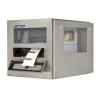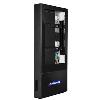5 Ingenious Ways to Improve Manufacturing Productivity With Office PCs

Computer downtime is the ‘Darth Vader’ of the shop floor, and as the film would say, ‘the saga continues.’ The quest to improve manufacturing productivity constantly hits the buffers because of failing IT equipment. If you want the ‘force to be with you’, here are 5 ways to re-purpose office PCs for industrial use...
Computer downtime is a blight on the manufacturing floor, responsible for costing firms hours of lost production time, man hours, customers and revenue. Relying on integrated, industrial PCs is proving to be a problem. Why? When they go wrong, there’s nothing manufacturing floor operatives can do about it.
Advanced industrial computers contain complex components, which means that those manufacturing them are the only ones who can carry out any repairs or software upgrades. They will make you pay for the privilege too (once any guarantees and warranties have expired).
The truth is, standard office PCs can give you all the perks that a purpose-built industrial computer can. Chances are, you already have a PC network which can be re-purposed, giving you a far more cost-effective and convenient way to improve manufacturing productivity, without the upheaval of having to install an entirely new system.
How to Use Office PCs to Improve Manufacturing Productivity

#1 - Data Collection – In an age where data is crucial to the manufacturing process, a reliable computer system is needed to gather vital information that’s pivotal to your operation. A standard office computer featuring the right software package can do just as good a job at collecting data as the most advanced industrial computer system.
#2 - Inventory Management – You don’t need the most advanced industrial computer to install the latest inventory management software. You can upload what you need to a standard PC for use on the shop floor, enabling you to monitor all aspects of your inventory and improve manufacturing productivity.
#3 – Shipping Records – You can keep track of your distribution using office PCs on the shop floor - all you need is the right software.
#4 – Staff Working Hours – A less popular use of PCs on the shop floor, but a necessity for your business as a whole. Connect computers to a clocking-in system for an effective way to log records showing the working hours of your staff. Being able to track man hours identifies gaps that you can plug to improve manufacturing productivity.
#5 – The Industrial Internet of Things (IIoT) – Office computers can connect to the internet, you don’t need the latest industrial PC to get your manufacturing floor hooked up to the web. Being able to do so will revolutionise your shop floor, making it smarter and more efficient, leading to a vast improvement in productivity.
Taking Office Computers to the Manufacturing Floor

Obviously, you can’t just take an office PC and place it in an environment as hostile as the manufacturing floor - that would be crazy. It wouldn’t last five minutes, either dust chokes it, liquids drench it or it ends up overheating, leaving you back at square one – facing downtime.
That’s where the mighty industrial computer enclosure comes in. It transforms your office PC into a shop floor ready computer that can withstand brutal manufacturing environments. Here’s what makes an enclosure so great...
...You stay in control. Where a purpose-built industrial PC requires a specialist engineer to repair or replace it, an enclosure allows you to replace or upgrade equipment on your terms. Rather than having to wait days, weeks or months to get vital IT systems up and running again, you can be back on track in hours.
The value of being able to do this is that you keep downtime to a minimum, reducing the impact of lost production, wasted man hours, customer complaints and loss of revenue. Enclosures are far more cost-effective too, cutting maintenance fees and improving your manufacturing firm’s bottom line.
It’s easy to get sucked into buying an over-engineered system equipped with the latest technology, when actually, you’re probably only using it for 10 percent of tasks. The truth is, your average desktop computer can help to improve manufacturing productivity just the same as a £10,000 industrial PC network.
















